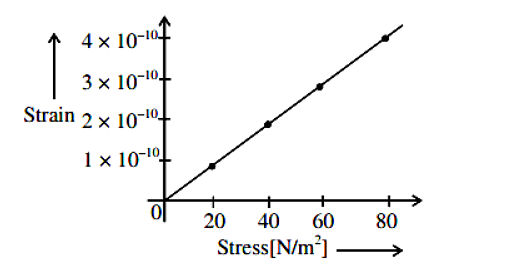A screw gauge gives the following readings when used to measure the diameter of a wire
Main scale reading : $0\, mm$
Circular scale reading : $52$ divisions
Given that $1\, mm$ on main scale corresponds to $100$ divisions on the circular scale. The diameter of the wire from the above data is :
- 0.52 cm
- 0.026 cm
- 0.26 cm
- 0.052 cm
The Correct Option is D
Solution and Explanation
To determine the diameter of the wire, we need to understand the readings given by the screw gauge:
The screw gauge uses two scales: the main scale and the circular scale.
The given data is:
- Main scale reading: \(0\, \text{mm}\)
- Circular scale reading: \(52\) divisions
According to the question, \(1\, \text{mm}\) on the main scale corresponds to \(100\) divisions on the circular scale. Therefore, each division on the circular scale corresponds to:
\(\frac{1}{100}\, \text{mm} = 0.01\, \text{mm}\)
Given the circular scale reading is \(52\) divisions, the value it represents in millimeters is:
\(52 \times 0.01\, \text{mm} = 0.52\, \text{mm}\)
Since the main scale reading is \(0\, \text{mm}\), the total reading (which is the diameter of the wire) is solely due to the circular scale:
\(0 + 0.52\, \text{mm} = 0.52\, \text{mm}\)
Converting \(0.52\, \text{mm}\) to centimeters (since the options are in cm):
\(0.52\, \text{mm} = 0.052\, \text{cm}\)
Therefore, the diameter of the wire is \(0.052\, \text{cm}\).
Thus, the correct answer is 0.052 cm.
Top Questions on elastic moduli
- The law which states that within elastic limits strain produced is proportional to the stress producing it is known as
- JKCET - 2024
- Physics
- elastic moduli
- The slope of the stress-strain curve in the elastic deformation region is
- JKCET - 2024
- Physics
- elastic moduli
- A wire of length L and radius r is clamped rigidly at one end. When the other end of the wire is pulled by a force F, its length increases by 5 cm. Another wire of the same material of length 4L and radius 4r is pulled by a force 4F under same conditions. The increase in length of this wire is ___ cm.
- JEE Main - 2022
- Physics
- elastic moduli
The elastic behavior of material for linear stress and linear strain, is shown in the figure. The energy density for a linear strain of 5×10–4 is ____ kJ/m3. Assume that material is elastic up to the linear strain of 5×10–4

- JEE Main - 2022
- Physics
- elastic moduli
- If the length of a wire is made double and radius is halved of its respective values. Then, the Young’s modulus of the material of the wire will :
- JEE Main - 2022
- Physics
- elastic moduli
Questions Asked in NEET exam
Three identical heat conducting rods are connected in series as shown in the figure. The rods on the sides have thermal conductivity 2K while that in the middle has thermal conductivity K. The left end of the combination is maintained at temperature 3T and the right end at T. The rods are thermally insulated from outside. In steady state, temperature at the left junction is \(T_1\) and that at the right junction is \(T_2\). The ratio \(T_1 / T_2\) is

- NEET (UG) - 2025
- Conductivity-thermal and electrical
- With the help of the given pedigree, find out the probability for the birth of a child having no disease and being a carrier (has the disease mutation in one allele of the gene) in the F3 generation.

- NEET (UG) - 2025
- Genetics
- Consider the diameter of a spherical object being measured with the help of a Vernier Callipers. Suppose its 10 Vernier Scale Divisions (V.S.D.) are equal to its 9 Main Scale Divisions (M.S.D.). The least count in the M.S. is 0.1 cm and the zero of V.S. is at -0.1 cm when the jaws of Vernier callipers are closed. If the main scale reading for the diameter is \(M = 5\) cm and the number of coinciding vernier division is 8, the measured diameter after zero error correction, is:
- NEET (UG) - 2025
- Measurement of length
- The plates of a parallel plate capacitor are separated by d. Two slabs of different dielectric constant \(K_1\) and \(K_2\) with thickness \(d/2\) and \(d/2\) respectively are inserted in the capacitor. Due to this, the capacitance becomes two times larger than when there is nothing between the plates. If \(K_1 = 1.25 K_2\), the value of \(K_2\) is :
- NEET (UG) - 2025
- Capacitors and Capacitance
- The correct order of the wavelength of light absorbed by the following complexes is:
A. $[ \text{Co(NH}_3\text{)}_6]^{3+}$
B. $[ \text{Co(CN)}_6]^{3-}$
C. $[ \text{Cu(H}_2\text{O)}_4]^{2+}$
D. $[ \text{Ti(H}_2\text{O)}_6]^{3+}$
Choose the correct answer from the options given below:- NEET (UG) - 2025
- Coordination chemistry